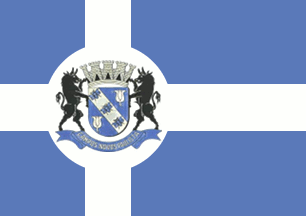 image by Dirk Schönberger,
11 October 2012
image by Dirk Schönberger,
11 October 2012Source: http://www.camposnovospaulista.sp.gov.br/a_cidade/p_simbolos.asp

Last modified: 2012-12-15 by ian macdonald
Keywords: sao paulo | campos novos paulista |
Links: FOTW homepage |
search |
disclaimer and copyright |
write us |
mirrors
 image by Dirk Schönberger,
11 October 2012
image by Dirk Schönberger,
11 October 2012
Source:
http://www.camposnovospaulista.sp.gov.br/a_cidade/p_simbolos.asp
A white off-centred cross on a blue field with the municipal arms on a white disk on the cross.
Official website at
http://www.camposnovospaulista.sp.gov.br/principal/index.asp
Dirk Schönberger,
11 October 2012
Campos Novos Paulista is one of the oldest municipalities in the Paranapanema. It was officially founded on 27 November 1868, as São José de Rio Novo, by the miner José Theodoro de Souza and his wife Francisca Leite da Silva, who, however had settled the place in the 1850s. The parish of São José de Rio Novo was established on 6 April 1878 by Provincial Law No. 16 and erected on 24 July 1878 a district part of the municipality of Santa Cruz do Rio Pardo. The town of Campos Novos de Paranapanema was established on 10 March 1885 by Provincial Law No. 25. The name of the town, lit. Paranapanema New Fields, recalls that the colonization of the region was later compared to that of the shore, of the surroundings of the State capital, and of the Paraíba valley. Campos Novos experienced its Gilded Age in 1890-1914; in 1908, the town counted five lawyers, one civil engineer, three land surveyors, two dentists and one photographer. The noted intellectuals Olavo A. Hummel, Otto Meusser and Bruno Giovanetti (1889-1955) lived in the town. Far from the railways and scoured by political division, Campos Novos declined during most of the 20th century. In 1938, the municipality was downgraded as the district of Bela Vista; in 1944, the district was transferred to the municipality of Ibirarema and its name was translated into Tupi, as Nuretama. The original name of Campos Novos de Paranapanema was subsequently reinstated, The municipality of Campos Novos Paulista was reestablished on 24 December 1948.
The flag of Campos Novos Paulista was designed by Lauro Ribeiro Escobar. The flag is blue with a white off-centered cross. Over the intersection of the cross' arms is placed a white disk charged with the municipal coat of arms.
The coat of arms of Campos Novos Paulista was probably designed by Lauro Ribeiro Escobar, too (this is not stated in the source but the wording of the description looks rather familiar). "Iberic shield, azure a bend argent charged with three bees of the first and surrounded by two lilies of the second. The shield surmounted by an eight-towered mural crown argent ports sable. The shield supported by two bulls sable. Below the shield a scroll azure inscribed with the toponym 'CAMPOS NOVOS PAULISTA' in letters argent."
The Iberic shield, used in Portugal at the time of the discovery of
Brazil, evokes the early colonists and builders of the country.
Azure is a symbol of justice, beauty, sweetness, nobleness,
perseverance, firmness, incorruptible virtue, dignity, zeal, loyalty,
recreation and recreation, alluding to the commitment of the
administrators, to the beauty of the environment and to the mildness
of the climate, which made of Campos Novos Paulista a Climatic Resort
nicknamed "Sapphire Sky Resort".
The bend, a division of first order, argent represents felicity,
purity, temperance, truth, frankness, integrity and friendship, the
basic virtues of the community life and also a reference to the purity
of the municipality areas.
The bees are symbols of activity, work, parsimony and sweetness,
emphasizing the activity of the administrators for the progress of the
place.
The lilies are symbols of candour and purity, recalling again the
wonderful climate of the municipality. They are also a tribute to St.
Joseph, the patron saint of Campos Novos Paulista, recalling the early
name of the place, São José de Campos Novos Paulista do Paranapanema.
The mural crown is a symbol of municipal emancipation. The open ports
symbolize hospitality.
The bulls represent animals useful for field work and symbolize
agriculture and cattle-breeding as a main source of income. Black is a
symbol of strength, constancy, prudence, simplicity, wisdom, gravity,
honesty and moderation.
Ivan Sache, 4 November 2012